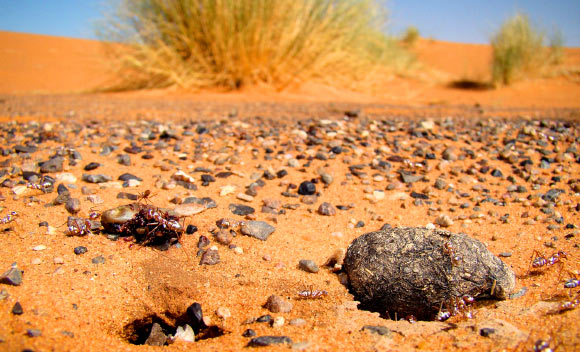An international team of entomologists from the United States and Switzerland is the first to demonstrate that the Saharan silver ants (Cataglyphis bombycina) use a coat of uniquely shaped triangular hairs to control electromagnetic waves over an extremely broad range from the solar spectrum to the mid-infrared, and that different physical mechanisms are used in different spectral bands to realize the same thermoregulatory function.

A nest of the Saharan silver ants (Cataglyphis bombycina) in Erg Chebbi, Morocco: outside the nest some ants are feasting on a camel tick; at the entrance to the nest is a piece of dry camel dropping. Image credit: Bjørn Christian Tørrissen / CC BY-SA 3.0.
Saharan silver ants are a dominant species in the sand dunes of North Africa. Their nests are huge and deep, with multiple entrances distant by several meters.
The ants are one of the most thermotolerant land animals known. They forage at body temperatures above 122 degrees Fahrenheit (50 degrees Celsius), and their critical thermal maximum is at 128.5 degrees Fahrenheit (53.6 degrees Celsius).
Entomologists have long been puzzled how these ants survive under such thermally extreme and stressful conditions.
Now a team of scientists, co-led by Dr Nanfang Yu of Columbia University and Dr Rüdiger Wehner from the University of Zürich’s Brain Research Institute, has discovered that the Saharan silver ants are covered on the top and sides of their bodies with a coating of unique hairs with triangular cross-sections that keep them cool in two ways.
These hairs enhance not only the reflectivity of the ant’s body surface in the visible and near-infrared range of the spectrum, where solar radiation culminates (the ants run at a speed of up to 0.7 meters per second and look like droplets of mercury on the desert surface), but also the emissivity of the ant in the mid-infrared (thermal radiation). This passive cooling effect works under the full Sun whenever the ants are exposed to the clear sky.
“To appreciate the effect of thermal radiation, think of the chilly feeling when you get out of bed in the morning. Half of the energy loss at that moment is due to thermal radiation since your skin temperature is temporarily much higher than that of the surrounding environment,” said Dr Yu, who is a co-author of the paper published in the journal Science.
The team found that the enhanced reflectivity in the solar spectrum and enhanced thermal radiative efficiency have comparable contributions to reducing the body temperature of silver ants by 5 to 10 degrees compared to if the ants were without the hair cover.
“The fact that these silver ants can manipulate electromagnetic waves over such a broad range of spectrum shows us just how complex the function of these seemingly simple biological organs of an insect can be,” said Norman Nan Shi of Columbia University, lead author of the study.
“This biological solution for a thermoregulatory problem may lead to the development of biomimetic coatings for passive radiative cooling of objects,” the scientists concluded.
_____
Norman Nan Shi et al. Keeping cool: Enhanced optical reflection and heat dissipation in silver ants. Science, published online June 18, 2015; doi: 10.1126/science.aab3564







